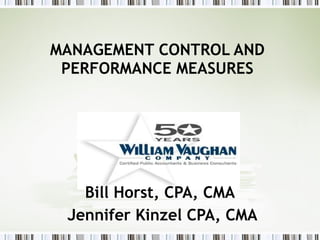Standard Cost Support
- 1. MANAGEMENT CONTROL AND PERFORMANCE MEASURES Bill Horst, CPA, CMA Jennifer Kinzel CPA, CMA
- 2. What Type of Clients do We Service? Revenue range from $100,000 to $150,000,000+ Average is from $5 - $25,000,000 Northwest Ohio and Southeastern Michigan Manufacturing, Health Care, Construction Contractor, Transportation and Logistics, Restaurant, Retail
- 3. Who Are We? We are a multifaceted team of Compliance Experts Professional Specialists Fraud Examinations Business Valuations Cost Segregation Studies Temporary CFO Assignments
- 4. Who Are We? Standard Costing Certified Management Accountant (CMA)
- 5. Standard Costing: The Vision â To have a system that accurately and simply reflects the activity cost of the productâ
- 6. What is Involved? Determining the Correct Cost Driver(s) Frequency of Revisions of Cost Model Budget Preparation Developing Accurate Standards
- 7. What is Involved? Monitoring Additional Applications/ Uses Financial Statement Presentation
- 8. What Can William Vaughan Company Do? Regardless of the system or method that the customer currently uses, WVCO has the unique experience to assist the client in UNDERSTANDING their cost system and IDENTIFYING what can be changed to achieve optimum results and information from the cost system.
- 9. Budget Preparation We have the experience and the tools to guide the client in creating an accurate budget that is linked to production.
- 10. Developing Accurate Standards The Company needs to understand and analyze current production information to create accurate standards for the allocation base.
- 11. Determining the Correct Cost Driver Selecting the wrong base on which to allocate overhead costs can create unexplained significant variances with changes in volume.
- 12. Frequency of Revisions to the Cost Model The most common misconception is that if variances fall out, the budget and or production standards should be changed continually.
- 13. Financial Statement Presentation The results of the system (variances) need to be accurately reflected on the monthly financial statements for management to effectively utilize the results.
- 14. Monitoring Management often does not know how to utilize the results that the system is generating.
- 15. Ėý
- 16. What is Wrong with the Current Method? ABC COSTING
- 17. What is Wrong with the Current Method? IT NEEDED SIMPLIFICATION 2 pages to calculate the rates ABC Model Simplified Model 52 pages to calculate the rates NO Variance Analysis 8 pages of Variance Analysis
- 18. What is Wrong with the Current Method? IT NEEDED TRANSPARENCY ABC Model Simplified Model ABC has multifaceted cost drivers and centers . The annual budget in dollars The annual estimated machine/ apportionment hours
- 19. What is Wrong with the Current Method? IT PROVIDED NO ACCOUNTING CONTROL ABC Model Simplified Model No reconciliation to general ledger Lack of understanding and complexity allowed formulas to be incorrect Contains check totals reconciling amounts to general ledger by month Built on Pivot tables which inherently are error - free
- 20. What is Wrong with the Current Method? IT PROVIDED NO VARIANCE REPORTING & RECONCILIATION ABC Model Simplified Model Did not provide Complete variance analysis for overhead, labor and materials
- 21. Because no one could UNDERSTAND it, it could not be used as an EFFECTIVE management and operations planning tool. What is Wrong With the Current Method?
- 22. What IS a Simplified Model? Simplification Transparency Accounting Control Variance Reporting Operations planning tool Understandability
- 23. Who was involved? Controller VP of Finance VP of Sales VP of Production Plant Manager VP of Engineering Members of IT- Internal and External Outside CPAâs
- 24. Who was involved? This was a TEAM effort. Each departmentâs decision is impacted by all of the others and each team member should be able to identify issues that might affect the next step in the process. Teamwork helps us to IDENTIFY and SOLVE any challenges that may arise during the process.
- 25. Indicators That it is More Than a System Issue Counterintuitive profitability results Erratic gross margins that are unexplainable Large unexplained labor, material, or overhead variances
- 26. What Could the Problem Be? Inaccurate material standards Inaccurate labor standards Inaccurate overhead standards
- 27. What Could the Problem Be? Ensuring integrity of product cost when current product structures may not be sound.
- 28. What Could the Problem Be? Customer believes there is an overall limitation due to the current software.
- 29. What Could the Problem Be? Not utilizing the information (variance reporting) that is derived from the current costing system to affect changes! Analyze monthly variances for reconciliation Act upon findings!
- 30. What Could the Problem Be? Direct Labor hours used as a standard did not include holiday and vacation hours. The corresponding direct labor dollars DID. Investigation of the variance allowed for this finding, and the resulting correction of their standards.
- 31. Results Activity Management Accuracy in Labor and Machine standards Accurate standards drive costing which allows the budgeting process to more closely mirror expected production
- 32. Additional Applications/ Uses Developing variance reporting for material price and quantity variances. The current overhead variances can be further extracted into a four-variance computation to provide specific detail.
- 33. Additional Applications / Uses Achieve the highest level of correlation between production and sales budget. Forces accountability and review of standards. Develop a âwhat-ifâ tool for management to utilize on a standalone basis for decision-making.
- 34. Thank You!
Editor's Notes
- #3: West to Williams, east to Sandusky, south to Putnam, clients in FL and West Coast
- #4: Greg and Aaron are Certified Fraud Examiners, (CFE) Greg is (FCPA) Forensic Certified Public Accountant, (CFF) Certified in Financial Forensics. Jack and Anne are Certified Valuation Analysts (CVA) Bill, Jennifer, and Tara are Certified Management Accountants (CMA)


































